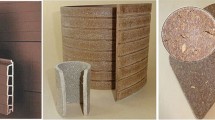Summary
High temperature (240°C) contact treatment was shown to be a very effective method of stabilizing panels bonded with heat resistant adhesive. Chemical analyses of post treated boards indicate that chemical changes of the wood components due to contact heat treatment were negligible. The results support the concept that high temperature post treatment of boards at temperatures above the softening points of lignin and carbohydrate components, caused plastic flow in situ which relieved internal stresses built up during hot pressing. Consequently, springback in wood-based composites diminished leaving panels much more stable than conventional products. Also, dimensionally stable wood-based composites had a better inherent ability to withstand severe exposure conditions than the regular boards.
Similar content being viewed by others
References
ASTM D1037.72a. 1986: Standard methods of evaluating the properties of wood-fiber and particle panel materials. 1986 Annual Book of ASTM Standards, Part 22. Wood; Adhesives. Philadelphia: American Society for Testing and Materials
Back, E. L. 1987: The bonding mechanism in hardboard manufacture, Review Report. Holzforschung 41: 247–258
BS 5669 1979: Specification for wood chipboard and methods of test for particleboard. British Standards Institution
Ernst, K. (1967): Möglichkeiten zur Verminderung der Quellung bei Spanplatten. Holztechnologie 8: 41–47
Hillis, W. E. 1984: High temperature and chemical effects on wood stability. Wood Sci. Technol. 18: 281–293
Hsu, W. E. 1986: Canadian Patent 1213707. Method of making dimensionally stable composite board and composite board produced by such method
Klinga, L. O.; Back E. L. 1964: Drying stresses in hardboard and the introduction of cross-linking stresses by a heat treatment. Forest. Prod. J. 14: 425–429
Koch, P.; Wellford Jr. W. L. 1977: Continuous tunnel kiln direct-fired with bark to dry 1.75 inch southern pine in 12 hours. Forest Prod. J. 27: 39–47
Orman, H. R. 1965: The response of New Zealand timbers to fluctuations in atmospheric moisture conditions. Tech. Pap. Forest Res. Inst. N.Z. Forest Serv. No. 8
Schneider, A. 1973: Investigation on the conversion drying of lumber at extremely high temperatures. Part II: Holz Roh-Werkstoff 31: 198–206
Spalt, H. A. 1977: Chemical changes in wood associated with wood fiberboard manufacture. In: Goldstein J. S.: ACS Symposium Series 43. Wood Technology; Chemical Aspects. pp. 193–219
Suchsland, O.; Enlow, R. C. 1968: Heat treatment of exterior particleboard. Forest Prod. J. 18(8): 24–28
Suematsu, A.; Hirai, N.; Saito, F. 1980: Properties of hot pressed wood. Part 1. Mokuzai Gakkaishi 26: 581–586
Author information
Authors and Affiliations
Additional information
The authors wish to thank G. Bastien and B. S. Lethbridge for technical assistance. One of the authors (W.S.) is grateful to the ‘Fonds zur Förderung der wissenschaftlichen Forschung’, Vienna, Austria for financial support (Proj. No. J0128C)
Rights and permissions
About this article
Cite this article
Hsu, W.E., Schwald, W. & Shields, J.A. Chemical and physical changes required for producing dimensionally stable wood-based composites. Wood Sci. Technol. 23, 281–288 (1989). https://doi.org/10.1007/BF00367742
Received:
Issue Date:
DOI: https://doi.org/10.1007/BF00367742




